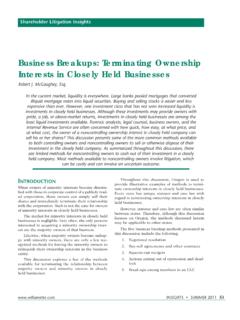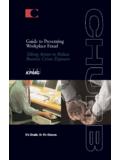Transcription of Indian Family Businesses: Their Survival Beyond …
1 Indian Family businesses : Their Survival Beyond Three Generations K. Ramachandran Indian School of Business Hyderabad -500 032 India Mail: Tel: 91-40-2300 7001 Fax: 91-40-2300 7046 Indian Family businesses : Their Survival Beyond three generations K. Ramachandran Abstract Interest in Family businesses is recent, and most often knowledge creation in this field is limited to Western academics. Although stray outputs have started appearing on developing countries or Asia in general, no comprehensive picture is still clear on most aspects of Family business. It is in this context that this exploratory research is undertaken. Family businesses constitute most businesses in India, as anywhere else. Economic liberalisation and rapid expansion in the industrial base in recent years have not only created growth opportunities for many but also have tested Their resource capabilities to respond to them; some have chosen to follow the role of a custodian of Their existing wealth and followed the preservation route, while some others have followed more of an entrepreneurial route of exploiting opportunities with or without relevant resources, with mixed results.
2 One of the key resources for all of them is Their Family , and Their prime concern is wealth and welfare of Their Family . A major dilemma many of them have faced particularly in the last decade since economic liberalization began is to choose between combinations of risks and returns of business growth and conservation of wealth of the Family . This, of course, is intertwined with the missions of Their businesses and families. Family businesses are fascinating because of the mutual dependence of two ecosystems ( Family and business) that have inherently conflicting characteristics. Some of the key dimensions that determine the cohesiveness of both the Family and business are: succession planning, remuneration and rewards planning, recruitment and rewards for non- Family professionals, retirement and estate planning, induction and grooming, ownership structure, preserving wealth, resolving conflicts, business vision, strategy and governance, Family vision, strategy and governance.
3 Research evidence suggests that these come under strain especially when Their operating environment comes under pressure. Growing interest in corporate governance has its positive effects on Family governance too especially in introducing greater level of professionalisation in business. The six Indian case studies analysed in this paper have been carefully selected: all fourth generation Family businesses with diversified portfolios, and managed jointly by Family members and outside professionals. However, they are different in terms of leadership quality across generations, response to environmental forces, Family unity and business performance. Families with a unified command and harmonious relationship have responded well to the economic liberalisation process that started in early 1990s. We conclude that the quality of Family leadership reflected in the level of Compassion Orientation nurtured in the families is found to be critical for building Competitive Orientation in the group s business.
4 Also, the nature and characteristics of Competitive Orientation required in business and Compassion Orientation required in families are influenced partly by the stage in Their life to which they belong and the impact of environmental forces existing. Families with high quality leadership have been able to transcend from early to later stages in Their life cycles smoothly. Indian Family businesses : Their Survival Beyond three generations Introduction Family as a social institution is one of the oldest surviving (Goode, 1982), but only in recent years Family business, an important arm of it started receiving academic attention. After a detailed review of the existing literature, Zahra and Sharma (2004) concluded that Family business research has a long way to go from the present fragmented and descriptive state.
5 There are conceptual differences between Family and business (Ward 1987, 2004), though opinions on treating them as conflicting systems vary. Family businesses are found to split up like amoeba as they grow, and very few of them survive Beyond three generations, supporting the age old saying, shirt sleeve to shirt sleeve in three generations (Carlock and Ward 2001, McCulloch 2004). Most discussions in this area are based on research in advanced countries. In most developing countries, including India, it still remains a black box; academics and industry observers were puzzled to witness the recent break up in the second generation of the Ambani Family , the largest private sector group worth over US $ 20 billion. Even anecdotal evidence is limited to a few biographical sketches (Tripathi, 2004; Piramal, 1998) and consultant impressions (Dutta 1997; Sampath 2001).
6 Sharma and Manikutty s (2005) study of diversified Family groups is one of the few notable research pieces from India in this area. In essence, not much is known either about the Survival rate or the factors contributing to the successful Survival of Family businesses in India. Taking the Survival bar as three generations, it will be interesting and instructive to know how Family businesses perform in the fourth generation. Since the implicit assumption here is that the Family has survived as a single entity, it is important to know how the Family s involvement in business is and also how the Family and outside professionals manage the business. Relevance of success of Family business For historical, evolutionary reasons, most countries have Family businesses constituting the largest category in terms of ownership; estimates do vary, but is above 75 percent in all cases (Duman 1992, Paisner 1999; Watts and Tucker 2004).
7 About a third of the companies listed in Fortune 500 are Family businesses (Lee 2004). Since they normally do not have short term orientation but are interested in growing the Family wealth with necessary precautions and have a different set of strategic goals compared to non- Family owned private companies (Ward, 1987; Sharma, Chrisman and Chua, 1997), Their long term contribution to economy is significant. This is true with the Indian economy too. However, long term sustenance of Family business depends on its smooth Survival across generations as shown in Figure 1. Families that successfully survive three or four generations have a complex web of structures, agreements, councils and forms of accountability to manage Their wealth (Jaffe and Lane 2004). This seems to be much more evident in the west compared to emerging economies such as India.
8 Reflecting the complexity of the process involved, succession planning has been an area of keen interest for researchers. This could be for a variety of reasons. One, organizational transition from an entrepreneurial stage to a system driven, professionally managed firm is not easy (Churchill, 1983), and involves evolutions, revolutions and crisies (Greiner, 1998). Two, there is often a simultaneous process of transformation taking place in the Family and business with the size of activities of both growing (Kepner 1991; Morris et al 1997; Sharma, Chrisman and Chua 2003). Professor K Ramachandran, ISB, HyderabadFamily and Organizational TransformationStage ISimple StrategySimple structureSimple System, ProcessesSmall teamHands onStage III & IVComplex strategyComplex structure (Stage III/IV)Complex systems, processesConscious value inculcationBusinessFamily s business management capabilities transformationGeneration III & beyondComplex interrelationships (structure)Value centred strategy implementationComplex systemsGeneration ILimited StrategySimple StructureInformal Systems, ProcessesSmall sizeHands onFamilyFamily s Family management capabilities transformationCrisisStage IICrisisCrisisGeneration IICrisisRequires compassion orientation through grooming, sharing, flexibility, social orientationRequires competitive orientation through grooming, leadership, strategy, entrepreneurshipTechno, economic, competitive environmentSocial environmentFamily Figure 1.
9 Family and Organizational Transformation There are also challenges of multiple stakeholders for the leadership position (Lansberg, 1999). Very often, there is lack of communication between the incumbent and incoming generations. The incumbents do not know how to handle the succession challenge, while the incoming generation does not know how to raise it. Studies in the American context showed that families choose Their most competent member(s) to manage the business, disregarding age, gender or bloodline (Chrisman, Chua and Sharma, 1998). This is a reflection of the Family s willingness to separate Family hierarchy from organizational hierarchy. Given the level of socio-economic and cultural contexts prevailing, it is difficult to be true in the Orient including India. However, post-succession role of the incumbent is not often planned leading to complications.
10 This could lead to what is often described as return of the father in 18 months into the business reflecting the retiring persons return to take charge of the business again. Hence, there is a need for determining the possible role of the incumbent as a mentor or non-executive chairperson. It is also possible for the person to pursue a totally different profession such as teaching! Retirement related planning is increasingly becoming important with growing longevity of people. Although ownership and management succession are the key concerns of a large number of business families, they do not devote enough attention to the process involved. Studies (Watts and Yucker, 2004) have reported that families hesitate to address this issue. Succession dilemma is also closely related to the Family policy on entry of new generation, retirement of incumbents and mechanisms for resolving conflicts.




